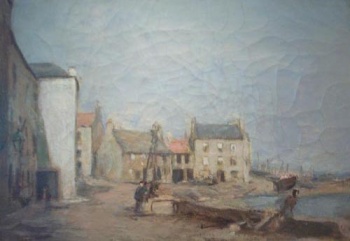Sir
James Lawton Wingate
1846-1924

Sir
James Lawton Wingate was born at Kelvinhaugh near Glasgow in 1846,
Wingate's career as a boy clerk in a Glasgow commercial house
was overshadowed by his taking drawing lessons in the early morning
before work. Ruskin's Modern Painters and Elements of Drawing
were a stimulus to him, as was the Pre-Raphaelite tradition, as
seen in Scotland in the paintings of Waller Paton. From pencil
studies, he constructed watercolour drawings which he exhibited
for the first time in 1864 at the Glasgow Fine Art Institute.
The
appreciation he received for his work induced him to give up all
thought of a commercial career and with £70 as his savings,
he went on a six months' tour of Italy (1867-68), where he studied
the works of the great masters and for the first time painted
directly from nature. The tour resulted in the production of about
150 watercolour drawings. After his return to Scotland he based
himself in Hamilton for about five years. The neighbouring Cadzow
Forest, beloved by Sam Bough and Alexander Fraser, gave him the
opportunity of careful study of tree forms, of which he made excellent
use in later life.
He
then moved on to Edinburgh, where he studied at the RSA Schools.
The turning point in his career came through meeting Hugh Cameron
at Comrie, in Perthshire, in the autumn of 1873. Cameron was a
genial and helpful critic. Wingate sturdily defended his work
as being true to fact; Cameron's reply 'I feel the work to be
wrong and art is not an affair of argument, it is an affair of
feeling' struck him with irresistible force.
In
1874 he went to Muthill, near Crieff, in Perthshire, painting
rustic subject matter such as 'The Wanderers' and 'The Quoiters',
which drew public attention. 'The Wanderers' ensured his election
to Associate rank in the Academy. From 1880-86 he made Muthill
his home and in the later years he gained full membership of the
Academy. Later he moved to Colinton and afterwards to Slateford,
both in the vicinity of Edinburgh and 1913 he came to the capital.
Thereafter
he came increasingly under the influence of William McTaggart
and his style became much more free, although with the same affection
for the Scottish Countryside. The sky as the source of light,
treated by so many painters in a perfunctory way is with him all-important.
Back
to Scottish Painters
|
